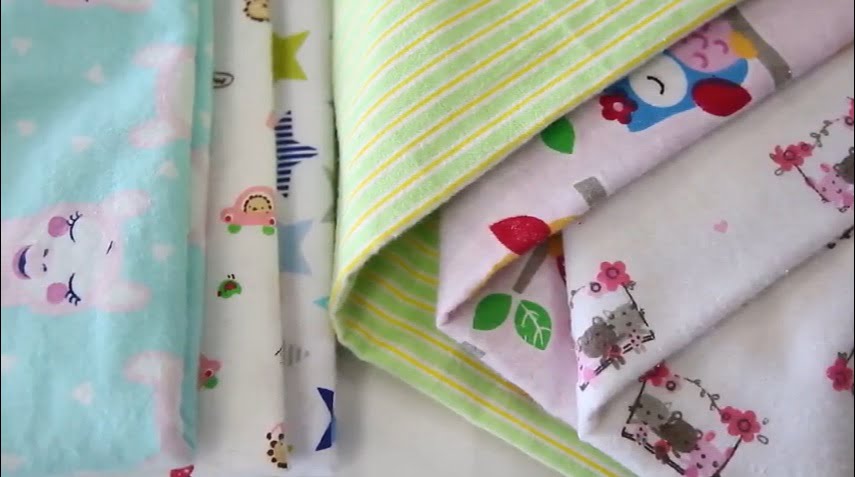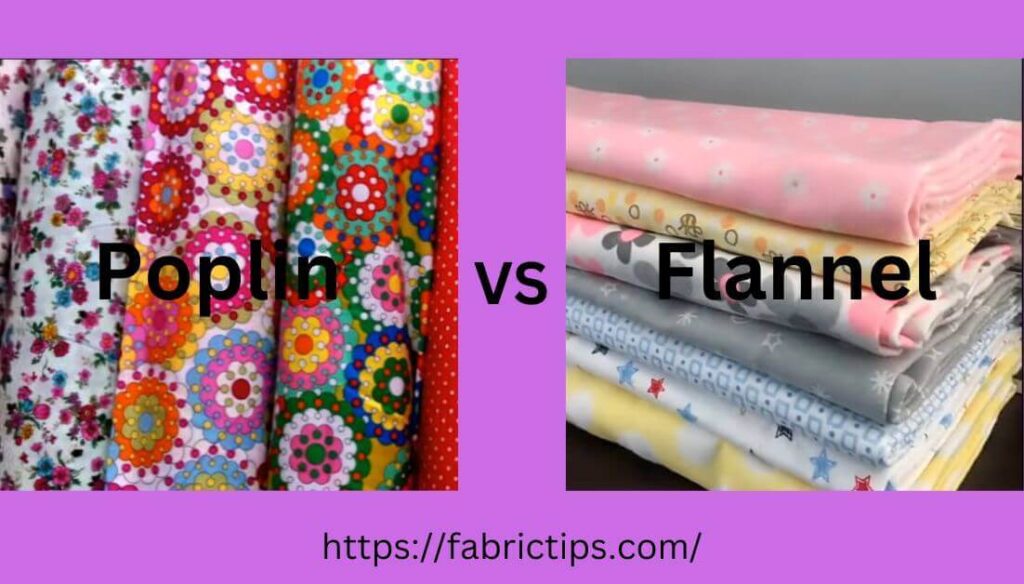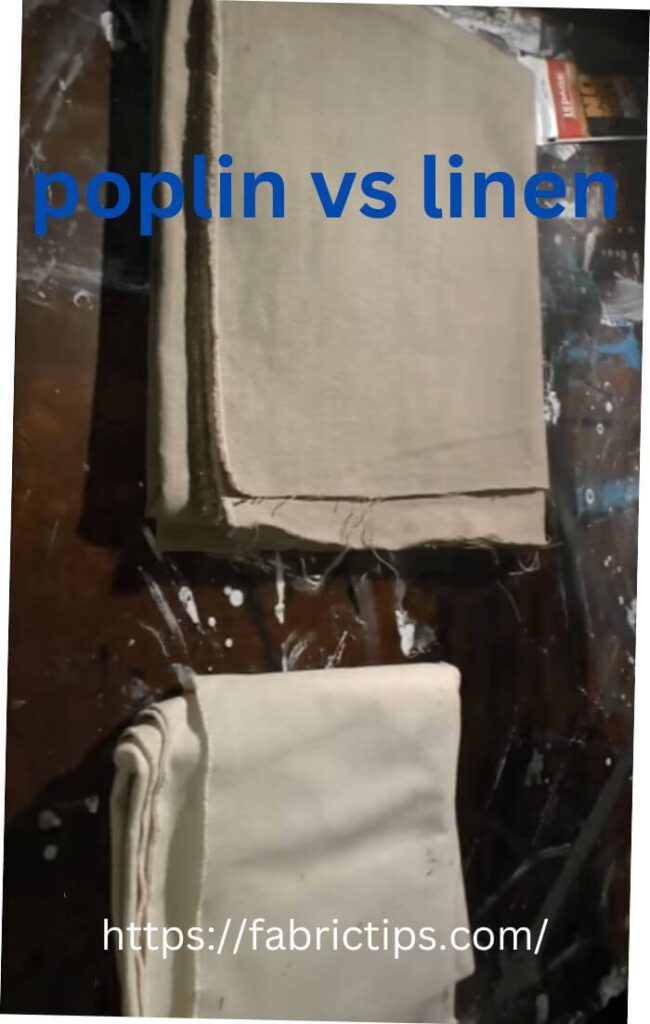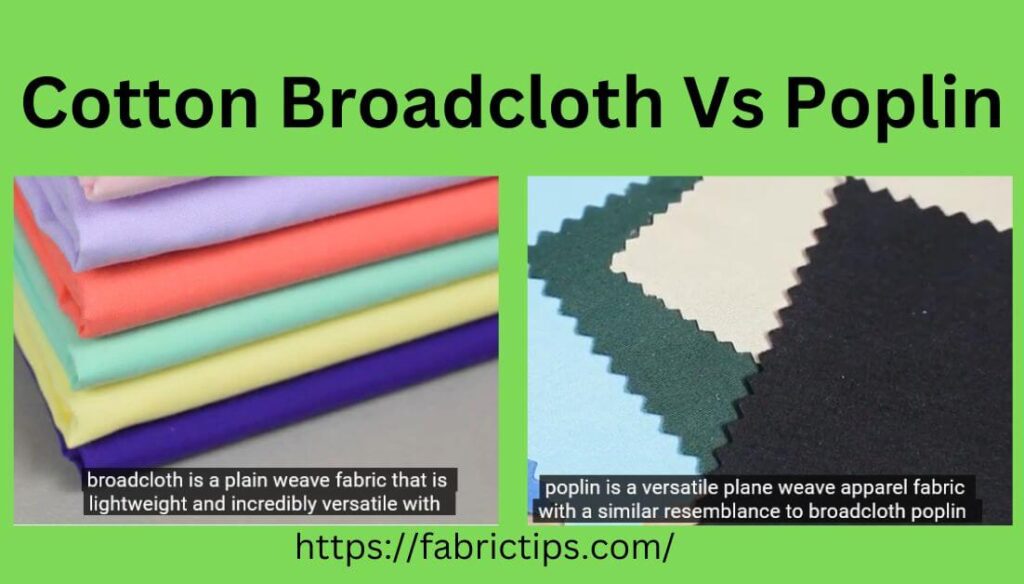Last Updated on February 19, 2024 by Wahid
Fabric is a flexible material composed of fibers, yarns, or combinations of them. Fabrics come in a variety of types and have different features. Today, we are going to discuss Poplin Vs Flannel more thoroughly.
Poplin is not even a little like flannel. The poplin fabric is incredibly tight woven, shiny and smooth, making it a popular fabric for jackets, pajamas, and shirts.
Flannel fabric is woven loosely and does not have a shiny or smooth finish. There must be a lot of softness in it. You can brush both sides or one side to create a napped surface.
Poplin and Flannel have so much to offer, and it is fascinating to know how they are manufactured. What makes them different from one another? Finally, who wins? Well, let’s explore them both below.
Poplin Vs Flannel: Table Of Comparisons
Here is a brief comparison between poplin and flannel before we get into an in-depth comparison.
| Poplin | Flannel |
| During the 15th century in “Europe,” wool and silk were used to weave “Poplin” | as early as the 17th century, “Flannel” was believed to have originated in “Wales” |
| The fabric is normally made from silk and worsted and is mainly used in women’s clothing | Usually made from wool, but may also contain synthetic or cotton fibers |
| Featuring crosswise ribs, this fabric features a plain weave construction | While flannel insulates and holds heat, moisture can still be wicked away from the skin |
| Considering its strong, durable but soft, lustrous surface, it is hardly surprising that it is popular | For winter months, blankets and sheets made from flannel are quite popular |
| Commonly referred to as tabinet fabric, the warp and weft yarns are very fine, with the warp yarns woven very tightly together | Since flannel is such a breathable and organic material, it does not matter if it is made from wool or cotton |
| This is a plain-weave fabric, which has a simple over-under weave (in contrast with complicated fabric weaves such as satin & twill) | Flannel doesn’t wrinkle easily because they are knit; spring and summer are also the perfect months to use it |
| Best for summer dresses | Best for winter dresses |
Poplin Vs Flannel: Deeply Comparison
Having seen a brief comparison of both fabrics above, let’s move on to a more detailed analysis of Poplin and Flannel. Read on, don’t delay any longer.
Poplin Fabric History
During the 15th century in Europe, wool and silk were used to weave poplin, which became a popular winter garment. ‘Poplin’ is derived from ‘papelaine’, named after the former papal city of “Avignon” (now obsolete). Featuring crosswise ribs, this fabric features a plain weave construction. Today, poplin is made from a wide range of materials, such as cotton, polyester, silk, and lycra.
Flannel Fabric History
“Flannel” was believed to have originated in Wales. However, as early as the 17th century, the term appeared in use in France under the name “flannelle.” The French & other European citizens periodically wore flannel during the “Enlightenment era.” Since then, however, the use of Welsh flannel has increased in recent years.
What Is Poplin Fabric?

If you ever wondered, ‘what is poplin fabric?’, then you’ve come to the right spot. Almost any type of poplin has been worn by you, from cotton-poly blends to 100% cotton poplins. While it was traditionally used as everyday attire, it is now incorporated into both everyday wardrobes & haute couture designs. Basically, it is a solid, all-purpose fabric that could never go wrong.
Various materials can be used for poplin, including cotton and cotton blends, polyester poplin and polyester blends, silk poplin, and lycra stretch poplin. Currently, poplin is made from wool, cotton, rayon, silk, polyester, or a combination thereof.
What Is Flannel Fabric?

There is a lot of talk about Flannel. Usually, when people refer to plaid shirts, they refer to them as “flannel” shirts. We’re talking about 2 circles here, one regarding “plaids” and one regarding “flannel” shirts. Indeed, there are plenty of overlaps, but some things fall into one category or another.
In essence, plaids aren’t always flannels. Obviously, flannel and plaid are two entirely different things. Wool can be used to make flannel, but cotton is also a commonly used material for flannel. Patterns and solid colors are both possible with flannel.
In addition to creating flannel, the company manufactures flannel sheets.
Where Is Poplin Fabric Made Of?
Today, poplin fabrics are primarily made of 100% cotton, making them lightweight while maintaining strength. When it comes to comfort, a poplin shirt is thin & cool with a smooth drape, yet is rugged and durable at the same time.
Ribbed and tightly woven poplin fabrics are distinctive for their texture & weave. As a result, the fabric acquires its lustrous appearance. In traditional poplin, the warp yarns were silk and the filling yarns were wool. The ribbed texture is created this way.
Where Is Flannel Fabric Made Of?
Globally, flannel is produced in several countries, with China being the largest producer. Flannel is a key product of “Shaoxing Haoyouduo Textiles.” India is one of the world’s largest producers of “cotton flannel.” Lastly, “wool flannel” is produced in Australia in greater amounts than in any other country.
However, the U.S. also produces flannel clothing. The United States’ largest manufacturer of Flannel Shirts. Moreover, Flannel clothing sells dresses, blankets, pajamas, jumpsuits, vests, and bedsheets.
Characteristics Of Poplin Fabric
Feels Smooth & Even
The tight weave of poplin makes it feel comfortable to wear, compared to knit fabrics that can feel ribbed and bumpy.
Lightweight
poplin is lightweight and thin, so it’s great for summer shirts, but it’s also transparent, so it often requires linings.
Long-Lasting
A poplin fabric can withstand heavy wear and washing machine. Additionally, it is wrinkle-resistant, making it a popular material for tablecloths, upholstery, and quilting items in the home.
Quite Affordable
Using poplin as a fabric or a garment is cheap since it is inexpensive to manufacture. There are many different kinds of poplin and they are available at various prices – the “cheapest is polyester poplin,” and the “most expensive is silk poplin.”
Easily Dyeable & Printable
The poplin fabric takes dyes & prints well, making it a versatile fabric for plaids, polka dots, and floral prints.
Characteristics Of Flannel Fabric
Soft & Durable
Flannels’ properties & characteristics differ slightly from model to model, however they share several similarities. In general, flannel is both soft and durable, whereas flannelette and synthetic flannel are the least long-lasting.
Breathable & Insulating
Flannel is both breathable and insulating, keeping you warm. In general, most fabrics are not known for being absorbent, but “diaper flannel” is one of the best. Furthermore, flannel has a tendency to resist wrinkles.
Flame-Resistant
Finally, flannel made of wool or synthetic fibers is flame-resistant. Basically, wool is natural, whereas synthetic fibers have been added.
Availability
Fabrics made of flannel are popular choices for winter suits, shirts, skirts, jackets, hats, gloves, sheets, scarves, and bedding. In addition to cloth diapers and baby clothing, flannel can also be made into dresses, pajamas, vests, and quilts.
Dry & Machine Washable
Machine washing and drying are usually easy and convenient methods for keeping the flannel fabric clean.
Features Of Poplin
- In addition to their clean & flat surfaces, poplin fabrics have a fine texture, full grain, soft and smooth hand feeling, and shiny and soft luster.
- However, poplin fabric has one major disadvantage, and that is that it tends to crack longitudinally when sewn.
- Poplin has very different warps and wefts due to its density difference.
- Additionally, warp strength is nearly twice that of weft strength due to unbalanced strength between warp and weft.
- Similar in appearance to broadcloth with even finer, more tightly spaced ribs, it has a heavier filling yarn and more warp yarns.
Features Of Flannel
- Flannel is usually made with carded yarns and is made in a twill or plain weave and cotton is filled with soft, fluffy yarns.
- Depending on the intended use, fiber composition and napping amount will vary. Man-made fibers increase the fabric’s abrasion resistance and may therefore extend its life.
- The blends also prevent stretching, resulting in a more comfortable fit. With acrylic fiber blends, crease retention is improved.
- A fine twill weave is usually used for outerwear, which generally uses wool, wool blends, or man-made fibers.
- All-wool flannel fabric can be minimized in felting & shrinkage by blending wool with man-made fibers.
- A washable men’s suit is made by blending wool with nylon, acrylic, or polyester.
Common Uses Of Poplin
- Poplin fabric is commonly used in a wide range of shirting items, such as casual blouses, button-ups, and shirts for men.
- The silk poplin shirt is very popular in cool climates; and cotton the poplin is very popular in warmer climates.
- Whether you’re wearing breathable tops or airy pants, poplin’s lightweight texture is ideal for summer.
- Pajamas made from poplin are ideal for loungewear because it’s comfortable and smooth.
- Poplin is an inexpensive fabric that is affordable to everyone. Hence, the material is popular in both hot & cold climates.
- There are many uses for poplin, including shirts, kamijs, skirts, blouses, and so on for people at all stages of life.
- In cooler climates, velvet poplin shirts are preferable, while cotton poplin shirts are preferred in warmer climates.
Common Uses Of Flannel
- Flannel fabric is most commonly used for shirts. During the fall and winter months, plaid and flannel shirts are popular choices.
- In addition to pumpkin patches and fireside chats, the fabric is often associated with blue-collar workers.
- Flannel can also be found for winter bedding, sheets, and quilts.
- While flannel provides excellent insulation, it’s not suitable for those who tend to sleep hot.
- Flannel dress vests, suits, skirts, and jackets are also popular for winter garments.
- However, plaid and flannel are different, and many people are unaware of the wide range of grays, blacks, solids, & neutrals used in flannel clothing.
- Further, due to flannel’s warmth, many people use it for hats, mittens, scarves, and gloves.
Disadvantages Of Poplin Materials
- Heat is not locked in. Despite its durability, this fabric will not keep you warm in the winter.
- However, poplin does not work for winter clothing if you wear it with a lining.
- Despite its popularity for summer wear, poplin is not a good choice for someone who lives in a cold climate.
- Too thin a fabric. Poplin is not the right fabric for heavyweight garments.
- Poplin should not be dried if it is made of polyester, since polyester may melt.
- In a washing machine, it should be washed on a warm or cold cycle, with no excessive heat applied.
Disadvantages Of Flannel Materials
- Flannel is mostly made of cotton, which contributes greatly to soil erosion & uses a lot of water in farming and production.
- Alternatively, sheep’s wool is used to make flannel, but some people don’t want anything that comes from animals.
- In general, synthetic flannel has the cheapest price; however, its flame-resistant coating may be toxic.
- During the winter, flannel sheets are very popular; however, they tend to pill and trap heat. Those who sleep hot should avoid flannel sheets.
- Flannelette is a material that catches fire easily & burns quickly. Therefore, if you use it for bedding & pajamas, ensure that it is flame resistant.
Different Types Of Poplin Fabric
In terms of spinning projects, poplin can be classified into the following categories:
- Fully Combed Poplin
Combed yarns are used both in the warp and weft of this type of poplin.
- Half Thread Poplin
Combed yarns are used only in the warp direction in this kind of poplin.
Poplin also comes in a variety of designs, weaving, and color options. The following are some of them:
Ordinary Plain Poplin:
Plain weave poplin is known as ordinary poplin. The material is made up of 98% cotton & 2% spandex. Poplin fabric that is shrink-resistant is widely used in home textile applications such as bedding, quilt cover, pillow case, mattress cover, and more.
Check Poplin
Plain weave fabric featuring a check pattern. The fabric is lightweight and versatile, making it ideal for mass-production clothing. Bias tape, flags, & creative crafts are made from check poplin fabric.
Satin Poplin
Combed yarn is woven into a plain weave fabric to create a satin poplin. A satin touch feels smooth and wrinkle-resistant. This fabric is widely used for linings, interlinings, bedding covers, garments, etc.
Jacquard Poplin
Featuring a tiny diamond jacquard pattern, Jacquard Poplin is lightweight, soft, and crisp. This fabric feels durable, yet airy at the same time. Shirts, blouses, and other apparel are commonly made with this soft, shrink-proof, tear-resistant, and sustainable fabric.
Printed Poplin
Woven fabric with a printed pattern is the best option for making clothing and apparel. The fabric is antistatic, quick-drying, and breathable.
Different Types Of Flannel Fabric
Modern flannel fabrics have a wide array of styles and colors to choose from.
Despite being 100% flannel, each has its own characteristics & properties.
Cotton Flannel
A cotton flannel fabric is the most common type of flannel. There are two types of flannel: regular cotton and organic cotton. Shirts, jacket linings, and bedsheets commonly use cotton flannel. In addition to being warm & insulating, it is also incredibly soft.
Wool Flannel
European flannel is mostly wool flannel, which makes sense because flannel was developed in the United Kingdom. However, wool flannel is occasionally known as Welsh flannel. Having been made of wool, flannel is moisture-wicking in ways cotton is not.
Ceylon Flannel
Originally named Ceylon, Ceylon flannel its name from Sri Lanka, where it was invented. A 50/50 blend of cotton or wool flannel is used to make a Ceylon flannel. A large British market for trade was available in Ceylon during British imperialism.
Vegetable Flannel
The word vegetable flannel seems funny, but it’s simply another word for Scots pine flannel. The fabric was developed by Leopold Lairitz in the 1800s. Vegetable flannel is made from forest wool or waldwolle, which is collected from pine trees.
Baby Flannel
Despite its softness and nap, baby flannel has a pleasing appearance. Consequently, baby clothing, blankets and bedding are made from it. Almost any fabric can be made into baby flannel, although wool, cotton, and mixtures of the 2 are the softest.
Diaper Flannel
There is nothing mysterious or difficult about diaper flannel, which is made specifically for cloth diapering. Diaper flannel has a nap on both sides, enhancing its absorbency & softening your baby’s skin.
Synthetic Flannel
As a manufactured flannel, synthetic flannel stands out, as it is usually flame-resistant. However, flame retardant coatings are applied to fabrics and are potentially toxic.
Flannelette
Flannel fabric is a comfortable, soft, and breathable material used to make bedding, pajamas, and sheets. Sadly, flannelette isn’t as durable as traditional flannel, and it usually only lasts for 1 year or 2. Quilting is usually done with flannelette.
Poplin Vs Flannel: Which Is Best For You?
In comparison between Poplin Vs Flannel, each is a completely different fabric. The poplin fabric is very tightly woven, smooth, shiny and it can be used for a wide variety of clothing items, such as shirts, jackets, pajamas, etc.
Alternatively, fabrics made of Flannel are often loosely woven & rarely shiny or smooth. It needs to be ultra soft. It is brushed on both sides to create a napped texture.
In this case, poplin fabrics outfits are suitable for hot climates & flannel fabrics outfits are suitable for colder climates as well.
However, the main question is, what works best between poplin and flannel? It depends on your situation, such as the weather, wearing purpose, and your personal preferences, and whether either fabric is best suited.
FAQ
01. What are the main colors of poplin fabric?
- Blue
- Black
- Pink
- Purple
- Yellow
- Gray
- Red
- Green
- White
02. When should I wear flannel?
Due to its warmth and softness, flannel is an ideal fabric for cold weather. To achieve the classic Americana look, wear long-sleeved flannel button downs with jeans. Flannel can also be used to make women’s dresses, and flannel tops can also be worn with high-waisted pants.
03. What fabric is similar to poplin?
Broadcloth is woven similarly to poplin. However, the yarns used to produce a much thicker and more durable fabric.
04. Cotton or Flannel, which is better?
Flannel and cotton both breathe well. Despite its fuzzy texture, flannel keeps you warm during the napping process. Despite being loosely woven, flannel is naturally warmer than cotton. In order to sleep cooler, choose cotton over flannel.
05. Is flannel a strong material?
It is composed of long, silky wool fibers woven tightly into a yarn, which is then woven into dense materials. In addition to providing a barrier against the weather and stink, flannel also utilized the natural properties of wool.
06. How hygienic are flannels?
Using the same wet flannel repeatedly promotes the growth of bacteria and yeast. Due to this, in particular, if you have a tendency to get vaginal infections, you should use disposable wipes or wash your genital area with fresh clothes after each cleaning.
07. Is poplin a good summer fabric?
Featuring a crispness & natural drape, it is cooling and a perfect summer option. What is a bad summer fabric? Generally, polyester is a sweat-soaked person’s nightmare, because of its stain-resistant and durable qualities.
Final Word
Poplin Vs Flannel: which one is better for your needs? In general, Poplin fabric is tightly woven, shiny, smooth, and is used to make a wide variety of apparel, including jackets, pajamas, and shirts. In contrast to poplin, flannel is a more loosely woven material that is never smooth, polished or shiny. Typically, the Flannel fabric must be extremely soft, so that one or both sides can be brushed to give it a napped appearance. Finally, the choice is yours, depending on the requirements you have.


